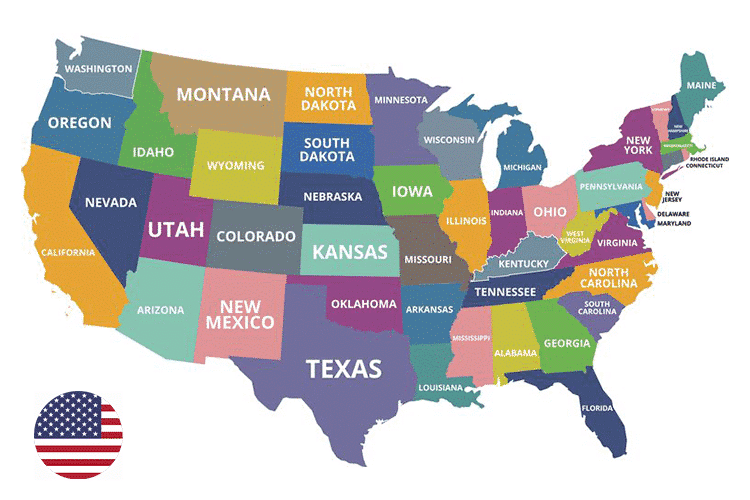EB-5 investment options
There are two investment options you can choose from to get the EB-5 visa, namely, direct investment and the Targeted Employment Area (TEA) investment. The direct investment demands you to make an investment of 1.050,000 outside the Targeted Employment Areas. The Targeted Employment Area (also known as the regional investment) requires you to make an investment of $800,000 in a rural area or in an area that has a high rate of unemployment. Below, we’ll provide you with information on TEA investments.

TEA rules and regulations
In the regional or TEA investment, you can either invest in a rural or high-unemployment area. For a region to be qualified as a TEA, then it should adhere to the following rules,
- The chosen area should either be a rural area or a high-unemployment area.
- An area with a national average unemployment rate of at least 150% qualifies as a high-unemployment area.
- For rural TEA, the chosen area must have a population of less than 20,000 and must be outside the Metropolitan Statistical Area (MSA).
- Both the rural area and high-unemployment area require Job Creating Entity (JCE) to create jobs in the chosen area.
Note: The regional center’s investments involve two important entities, namely, the New Commercial Enterprise (NCE), and Job Creating Entity (JCE). The NCE is where the immigrant will invest, and the JCE is where the NCE invests or loans the EB-5 investment funds, to create jobs.


TEA evidence and methodology
There is not much data provided by the Department of Homeland Security (DHS) to confirm whether an area qualifies to be a TEA or not. However, the unavailability of clear data and methodology gives the applicants flexibility in proving the TEA designation. One condition is that the data must be from a reliable and verifiable source. According to DHS, the data under the Bureau of Labor Statistics (BLS), and American Community Services (ACS) are reliable and verifiable. Therefore, these two datasets can be utilized to gather evidence to prove that an area qualifies for TEA investment.
You can see a map of TEAs here.
The TEA designation is judged as part of the I-526 application. However, new rules state that the States are no longer allowed to certify high-unemployment TEA. Therefore, the applicants need to include evidence to prove that the area falls under high-employment TEA at the applicable time of determination.
| Evidence for high-unemployment area |
|
| Evidence for rural areas |
|
Filing TEA – Best practices
Let us look into some of the best practices to follow to ensure that the TEA filing goes smoothly.
- If you are seeking to invest in the TEA project, you must check with an expert on due diligence to verify whether the project meets all the program requirements or not.
- For defining the TEA geographic area, ensure that you use direct references to the new regulations.
- Make sure the sources are reliable and verifiable, and they easily point to the data referred to online.
- Provide all the steps of the calculation process in detail.
Your I-526 petition for TEA qualification will be denied if you fail to present acceptable data. It is important to note that if your petition is declined then this will waste your time and cause financial losses. A denial of the petition results in wasting your significant time in getting a Green Card along with financial losses.
Source of funds


As an EB-5 investor, your income may have come from different sources. The USCIS thoroughly verifies your source of income to combat money laundering problems. You must provide valid proof of the source of your income, and make a strategic decision with your immigration attorney on which source to use for the investment. Also, there should be a lawful path for your investment. Path of funds is the documentation of how you have acquired the funds and invested the money in the new commercial enterprise in the US.
What are the different sources of income for an EB-5 Investment?
Your investment money can be from various sources, for instance, stocks, patents, business ventures, real estate assets, etc. Your funds can also be from securities or bank account deposits. Regardless, all investments you make should be traced back to the source of origin.
Source of funds and documents
If you have different sources, you will need to sit with your immigration attorney and discuss which funds to use and which not to. Choosing the fund strategically is critical. Your documents must be complete and valid. If you are not from an English-speaking country, and your documents are not in English, then you need to get the document translated.
Loans as a source of fund
If you obtain funds for the EB-5 investment from a third party, you need to document the source of the fund. For instance, a loan taken from a financial institution or a bank. When you are using credit, you are required to include the collateral. It is recommended to take a loan not more than 70% of the value of the collateral. The USCIS may request you to provide evidence (RFE) if the collateral value is close to the value of the loan you have taken.
Also, from April 14, 2021, USCIS is now approving unsecured loans as a source of funds for the EB-5 investments.
Tax returns and documentations required
As an investor, you need to have the individual and corporate tax returns (if applicable) for the last five years in any jurisdiction. All the financial statements that you include must go through an audit. If your tax returns show higher income in the previous year, then you need to submit tax returns for the three years with the highest income. It is recommended that you do the EB-5 tax planning with an expert before filing.
Let us look into some of the eligible sources of funds and their respective documentation,
Real Estate
For real estate assets, you must submit the mortgage and deed documents for all the properties you own. If you are earning through lease or rental, then you need to include the lease document as well. For all the pledged real estate assets, you must provide appraisals for up to three years.Business Ventures
You must include an accountant’s appraisal of all businesses in which you own a substantial or controlling interest. This includes the business outside or inside the U.S. You must also provide proof of ownership and business registration records.Bank Statements
Three years of bank statements from all the banks you hold accounts in. The statement should show the withdrawal of the amount from one account and the deposit of funds in another account. You must get a letter from the bank supporting your transactions.Investments
You must hold stock certificates that show a record of all the investments and security accounts for the past 3 years. If you have made capital gains in your investments in the past years, then you must include the supporting documents for the same.Are gifts, divorce settlements, and inheritance eligible as sources of funds?
Gifts, divorce settlements, and inheritance are eligible sources of funds and they require supporting documents to be considered as investment funds.
- If your investment in the EB-5 project is from the inheritance you acquired, then you must provide proof of inheritance, such as settlements of the deceased.
- If the investment is from the gift that you received, you must include the registration of the money and the gift giver’s source of income.
- In case of divorce, you must include the official court judgments, alimony, and proceeds of civil lawsuits.
Missing documentation
In case you are unable to provide any of the mandatory documents at the time of visa application, you can file a missing document declaration along with your application form. Although USCIS does accept the declaration at times, however, we would advise you to keep it as your last option. Provide a declaration only you are left with no other choice.
EB-5 job creation requirements
The USCIS expects you to create or preserve at least 10 American jobs for you to get the EB-5 immigrant visa. You must create these jobs within two years after receiving your conditional permanent residency.
- In the case of direct investment, you need to provide proof that you have created direct jobs in the commercial enterprise that you have made investments in.
- In the case of regional investment, you need to provide proof that you have created direct, indirect, or induced jobs with your investment.
EB-5 business entities
The two entities involved in the EB-5 investment are NCE and JCE. The NCE comes in different business structures, such as partnerships, corporations, business trusts, publicly or privately owned businesses, and sole proprietorships. As an EB-5 investor, you should invest in the NCE which is a for-profit U.S. business.
Direct investments are made directly to the businesses that create the jobs. In the case of the regional investments, the investments are made into the NCE, which is also called the EB-5 fund. The NCE then loans the fund to the JCE.
All the NCEs that you invest in must have been established after November 29, 1990. The old enterprises qualify only when the capital investment increases the company’s net worth or the number of employees by 40%. Also, if the old business is renovated to form an NCE, then it may qualify for EB-5 investment.
EB-5 Visa requirement gist
As a summary of the whole article, some of the major points to keep in mind is,
- The investment amount is $1,050,000 for direct investment and $800,000 for the regional center program.
- The proof of lawful sources and pathway of your investment.
- The investment you make must be made in a for-profit commercial entity in the U.S.
- Your EB-5 investments must create at least ten American jobs directly or indirectly within the first two years of your conditional residency.
- Direct investments are made directly to the commercial enterprises that create the jobs.
- In the case of regional investments, the investments are made into the NCE, also called the EB-5 fund. The NCE then loans the fund to the JCE.
Related articles
To find out more about immigration opportunities, investment visas, and work visas in the United States, the following articles may be useful:
- What is the best US Investor Visa to apply for?
- EB-1 Green Card US – The Ultimate Guide by Experts
- How to Get a USA Investor Visa
- E-2 Visa USA 2023 – The Ultimate Guide by Experts | GCS
- EB-5 Visa USA 2023 – The Ultimate Guide by Experts
- The E2 Visa to Green Card – Step by Step Guide
- E2 Visa Renewal and Extension- A Detailed Guide
- E2 Visa Requirements – A Detailed Guide
- Investment Green Card: The Difference Between an EB5 Visa & E2 Visa
- E2 Visa Renewal and Extension- A Detailed Guide
- EB5 Green Card Process Steps – Ultimate Guide | GCS
- Investment Green Card: The Difference Between an EB5 Visa & E2 Visa
- All You Need To Know About the EB5 Visa Costs
- O-1 Visa US
- EB-2 NIW – National Interest Waiver US
- Why You Should Consider Hiring an EB-1 Visa Lawyer
Frequently Asked Questions
How long does it take to get an EB-5 investor visa?
It takes an average of 13 months to get an EB-5 investor visa, from the time of your application submission with the USCIS.
Which countries can apply for an EB-5 investor visa?
Anyone can apply for the EB-5 visa by fulfilling the requirements. 80% of the applicants are from China, the United Kingdom, South Korea, and Taiwan.
How does an EB-5 visa program work?
The EB-5 visa was launched to attract foreign investments and to enhance the U.S economy. Those who are interested can invest the required amount in U.S commercial enterprises and meet the EB-5 immigrant visa requirements.
Do I need a lawyer to apply for an EB-5 visa?
If you try to apply for an EB-5 visa application and fail, this will be a huge loss of time and money. Therefore, it is recommended to seek the assistance of a lawyer to help you with your application.
What is the minimum investment one can make to be eligible for the EB-5 visa?
The minimum investment amount to be eligible for the EB-5 visa is $800,000 in the TEA or regional centers and $1,050,000 if it is a direct investment.


